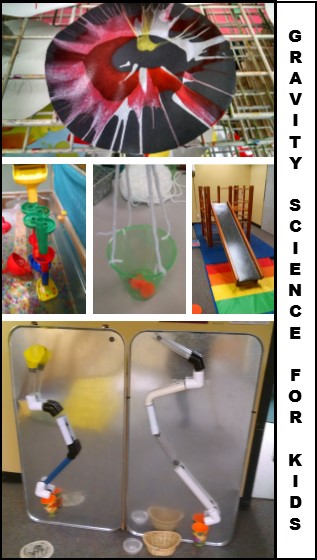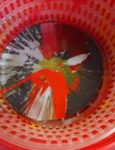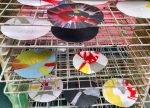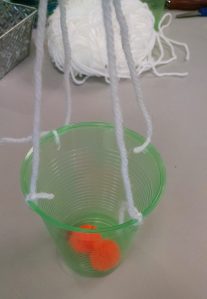At this week’s class we talked about Force, Magnets, and Gravity.
Hands-On Exploration of Gravity
Slide: We set up our climber and slide. The slide is a great way to learn about gravity! It’s really easy to slide down, and sliding up just doesn’t work.
Pulley: We mounted a pulley on the slide, a callback to when we studied Simple Machines last quarter. They could clearly see that if they filled the basket up top, and then let go of the rope, gravity would carry it down to the ground with no effort on their part. If they wanted to raise the basket back up, they had to work (use force) to haul it back up.
Gravitational Impact Testing: Next to the slide, we placed a tub full of Kinetic Sand. (Last year, we had it in a tub on a drop cloth. This year, we put the sand inside a gallon ziplock… but, of course, we had a child open the ziplock, so we probably had the same amount of spillage with both methods.) We put out a wide variety of light and heavy objects. Kids climbed to the slide platform, then dropped an object into the sand to see if it left a mark, what shape the mark was, and how deep the impact crater was. (Safety pointer: kids on the ground love to look at the craters, and lean over for close examination – it’s important that the kids on the platform know to wait for all heads to be clear before they drop the next object! None of our objects were heavy enough to injure, but they might have stung if they hit someone.)
Marble maze:  These building toys offer great tinkering opportunities. Kids build, notice problems, re-build, test, decide to re-build to make it taller, and so on. I especially like our set, which is from Discovery Toys
These building toys offer great tinkering opportunities. Kids build, notice problems, re-build, test, decide to re-build to make it taller, and so on. I especially like our set, which is from Discovery Toys, because it includes a gravity well, a launch track where you can load 6 – 12 marbles, then dump them in all at once, and other fun details.
I did learn something important – I’d originally put this on a table top so it would be easy to build and watch the marbles roll down. But, what I hadn’t taken into account was that for small children, it was then hard to reach the top to drop a marble in. So, the kids climbed on the table to reach the top! (OK, it was my kid was doing that… ) So, we moved it to the floor.
This year, we moved the marble maze into the water tub, and let kids pour water beads and water through it. They’ve played with the marble maze before, and played with water beads, so it was fun to combine the two.
Magnetic ball wall: Based on that standard children’s museum activity, this marble maze is a DIY project (learn how here) using PVC pipes mounted on magnets, stuck to metal oil drip pans, and shooter marbles to run through it. Again, it’s a great tinkering toy – especially because after you finally get everything lined up just right, you’ll run three or four marbles through successfully, then marble #5 bumps something just slightly out of alignment and a marble gets stuck, or marble #6 really knocks it out of line and marbles fall and you have to re-build. We also set up the maze pieces on our metal slide (see photo in magnet post.)
Gravity well: At many science museums and children’s museums and such, they have a donation bucket where you drop a coin in and it circles around and around and around before finally spiraling down. (The gravity pulls the ball down, but the momentum of the spin slows that fall.) This is an example of centripetal force, as it spins in toward the center.
We invented a mini gravity well with a colander and a shooter marble. You could just use those two items – we added a rubber mat into the center to make it more obvious when it reached the center (because the sound stops as well as the motion). Kids have to learn how to hold it and move it just right to get the ball to spin, so it’s also a chance to learn a new motor skill. Check it out:
Art – Salad Spinner. Prep – cut circles of paper, fill squirt bottles with paint. In class: kids place paper in bottom of spinner basket. Squirt some paint in the middle of the paper. Put the lid on and spin it! Centrifugal force pushes the paint toward the outside of the paper.
Building Project: Centrifugal Force Air Ship
Materials: paper bowls or plastic cups, string, scissors, hole punch, and optional materials to decorate ship with. Plus small “passengers” for the ship – could use pompoms or small plastic animals, or whatever you have.
Directions:
- Punch holes in the cups or bowls, attach 3–4 lengths of yarn and tie them together.
- Fill the ‘ship’ with 5-7 objects as ‘passengers’
- Start swinging the ‘ship’ around until it can go over your head and see if you’re able to keep passengers in your Centrifugal Force Ship – “CFS”
Note: again, kids are also learning a motor skill with this activity. They had to learn how to start swinging the ship slowly, then faster, then up over their head to keep the pompom in. If you don’t want to have kids build these as a project, it would also be easy to make up a couple before class just for them to play with at outside time.
Learn about the science: http://sciencenetlinks.com/afterschool-resources/fun-forces/
Pendulum painting: I want to do pendulum painting, as described on Handmade Kids Art, Martha Stewart, Growing a Jeweled Rose, Teach Preschool and Science World. I thought it would be a good fit for gravity week, as it ties into centrifugal and centripetal force.
Last week, I made a seismograph for earthquake week. I had an inspiration – could I re-purpose this for pendulum painting this week??
I unfortunately didn’t have time to test the idea before class. When I tested it in class, it failed. I tried to tape over the hole on the bottle while I filled it, and then take off the tape to spin it. At first, the paint was too thick, and wouldn’t come through the hole. But then when I watered it down, it was too thin, and ran out even when the tape was supposedly covering the hole.
I’ll try again next time, when I have time to test it. I think I will build a frame with PVC pipe. I think I will follow Jeweled Rose’s lead and will use a Gatorade bottle or water bottle with a sipping lid – the kind that you can push closed and pull open. Then I can cut the bottom off the bottle, mount it on the pendulum, and refill it as we go along.
Circle Time
After the children have had time to explore all the activities, we gather for circle to give them the conceptual framework of the day, then we send them out to explore all the activities again, with these new ideas.
Big Idea: The key ideas I wanted to convey were that gravity is an invisible force. You can’t see it, but you can see how it affects other things. Gravity pulls toward the center of the earth, so when you drop things, they fall down. You can use energy to jump into the air, but then gravity pulls you back to the ground. (In the Next Generation Science Standards, gravity appears in third grade, under 3-PS2-1, where it simply notes “assessment is limited to gravity… as a force that pulls objects down.”)
Song: We had sung a fun song to the tune of Have you Ever Seen a Lassie for Magnet week, so I wrote a gravity song to that tune. On Magnets, we swayed left and right when singing the words “this way and that way.” For this song, we stood up. When it said “pull this way” we crouched down, and when it says “not that way”, we stood on our toes.
Well, you’ll never see gravity, gravity, gravity
But you can see gravity pull this way, not that.
Chorus: Pull this way, not that way, pull this way, not that way.
You can see gravity pull this way, not that.
You toss up a ball, gravity makes it fall
Oh, you can see gravity pull things to the ground.
(Chorus)
You throw up a gown, gravity brings it back down
Oh, you can see gravity pull things to the ground.
(Chorus)
There’s an alternate gravity song here.
Discussion: I started this circle with the discussion described in the Force post, where I set a block on the table, and asked if I could move it with my mind, or order it to move. The kids guided me through applying force by pushing and pulling. Then, I asked “What if I want to move the block to the ground? Do I have to hold it in my hand and PUSH it down to the ground? Now? I can just nudge it over the edge and it will fall down?? Why? Yes, there’s an invisible force called gravity that pulls things to the ground, or as close to the ground as it can get. When the block was on the table, it was trying hard to get to the ground, but it couldn’t pass through the table, so it laid on the table. When I hold it up in the air like this, then let go, it can pass through the air, so it falls down to the ground.
Book: Then I read I Fall Down (see below) which includes several demos like tossing balls, keys, and more up in the air and watching them fall back down, having a dropping race, first with a penny and a block, then with the block and a feather, then using a bar of soap and a dry sponge to show that things fall at the same rate, but that heavier things fall harder and you feel that harder impact on your hand.
Optional demo: You could tie a whiteboard eraser (or other soft object with a little mass) to a string, and spin it over your head. Explain that you’re the earth, the eraser is the moon, and the string is the force of gravity that prevents the moon from escaping earth’s orbit.
Books
-
- I Fall Down
is another fabulous book by Vicki Cobb. It does a great job of clearly explaining to 3 – 6 year olds the basics of gravity with lots of hands-on examples of experiments they can do with materials they have at home.
- Gravity Is a Mystery
by Branley. A good option for 6 – 8 year olds. It has enough detail that it might be better to use as a second or third book about gravity, not the first introduction. It goes into details like that gravity pulls you toward the center of the earth, what would happen if you dug a hole through the earth, and about how much gravity there is on other planets.
- What Is Gravity? by Trumbauer. Ages 3 to 5, good photographs, situations that are relatable for kids like going on a swing or sliding down a slide or apples falling from trees. Conveys basic concept that things that go up come back down because of gravity and that heavier things are pulled on more by gravity. Does not address pull toward earth. A really solid read-aloud non-fiction for preschool – just not as good as I Fall Down.
- Why Can’t I Jump Very High? A Book About Gravity
by Prasad. Best for 8 – 10 year olds. Really wordy, and covers a LOT of concepts: starts with kids asking why they can’t jump higher in basketball. Covers gravity on earth, gravity on the moon, Aristotle and Newton, drop tests, air resistance and friction.
- Gravity
by Chin. This is a picture book. It has beautiful illustrations and really sets a tone and mood. There are just a few words on each page – the complete words in the main text of the book are: “Gravity makes objects fall to Earth. Without gravity, everything would float away. The moon would drift away from the Earth. The Earth would drift away from the sun. Luckily, everything has gravity. Massive things have a lot of gravity and their gravity pulls on some other things. Gravity keeps the earth near the sun, the moon near the earth, and makes objects fall to earth.” Then on the last two pages of the book, there’s additional info on gravity, mass, weight, and that gravity is weaker with distance.
- I Fall Down
Preview or Review Videos: Intro to work and gravity: https://www.youtube.com/watch?v=LEs9J2IQIZY Song about gravity: https://sciencepoems.net/gravity-song-video/; Schoolhouse Rock – A Victim of gravity: https://www.youtube.com/watch?v=5WwcB4o1x_4 Search on YouTube for Bill Nye gravity. There’s also a Sid the Science Kid on gravity.
Follow-Ups: For “homework” – here are some things parents could do with their kids to reinforce the ideas learned in class.
- Talk about what would happen if there was no gravity.
- Perhaps watch videos that show astronauts floating in space, and talk about what that would be like. (Go to YouTube and search for “NASA zero gravity”).
- Play with dropping objects to show that they fall at the same rate… if kids notice that feathers or flat pieces of paper fall slowly, then discuss that this is due to them being caught on air currents, not because gravity works differently for them.
- Look for more gravity ideas here: http://www.stirthewonder.com/gravity-lab/












[…] Gravity – Science for Kids […]
LikeLike
[…] Gravity – Science for Kids […]
LikeLike
[…] Gravity – Science for Kids […]
LikeLike
[…] Gravity – Science for Kids […]
LikeLike
[…] Theme – Gravity […]
LikeLike
[…] Theme – Gravity […]
LikeLike
[…] Physics: Magnets, Gravity; Light and Shadow, Rainbows […]
LikeLike
[…] are one of the best possible toys for learning the tinkering mentality, while also learning about gravity and inclined planes. I have instructions for how to build one with PVC pipes plus ideas for […]
LikeLike
[…] Mars rovers or a lunar rover toy in sand is a fabulous play opportunity. Or, you can do “gravitational impact testing” by putting out a tray of flour or sand or soft clay and letting them climb up high and drop […]
LikeLike
[…] use this in gravity week as we talk about how we invent things to help us work against […]
LikeLike
[…] salad spinner paintings. Put a circular piece of paper in the bottom of the spinner basket. Drip on some (non-toxic) paint, […]
LikeLike
I hate to mention this but a rotating mass “EXERTS” a centrifugal force, it is not subject to such a force. It should be obvious a rotating mass cannot be subject to both a centripetal force and a centrifugal force.
LikeLike
Thanks for the correction!
LikeLike
[…] a marble. You can make a simple maze, a complex labyrinth, a pachinko machine… We do this in Gravity […]
LikeLike
[…] best possible engineering toys for learning the tinkering mentality, while also learning about gravity and inclined planes. We had our homemade ball wall from PVC pipes, our Tumble Trax, and […]
LikeLike
[…] outside into the park and explore the physics of projectiles – learning about force and about gravity while having tons of fun throwing balls, shooting arrows, and launching rockets. It also links back […]
LikeLike
[…] rover toy in sand is a fabulous play opportunity. Or, with what you already have, you can do “gravitational impact testing” by putting out a tray of flour or sand or soft clay and letting them climb up high and drop […]
LikeLike
[…] the ball doesn’t move. We use this project in the week where we study gravity. (Find more hands-on gravity experiments […]
LikeLike
[…] the best possible engineering toys for learning the tinkering mentality, while also learning about gravity and inclined planes. I have instructions for how to build one with pipes plus ideas for simpler […]
LikeLike
[…] the best possible engineering toys for learning the tinkering mentality, while also learning about gravity and inclined planes. I have instructions for how to build one with pipes plus ideas for simpler […]
LikeLike
[…] Explores pushes and pulls, such as those caused by gravity, magnetism and mechanical forces. Uses tools and materials to design and build a device that causes […]
LikeLike
[…] the best possible engineering toys for learning the tinkering mentality, while also learning about gravity and inclined planes. I have instructions for how to build your own with PVC pipes plus ideas for […]
LikeLike